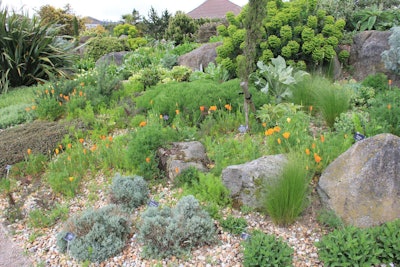 Just because a garden is conserving water doesn’t mean it can’t be vibrant and green.
Just because a garden is conserving water doesn’t mean it can’t be vibrant and green.Photo: Karen Roe/Flickr
The West isn’t the only part of the country that suffers from drought, and even areas that aren’t currently in a drought can benefit by conserving water.
There is a wide spectrum of opportunities when it comes to ways to reduce water usage in the landscape, from minor changes to complete overhauls.
For those who have clients wanting to make a switch, fall is prime time for many of the options available. Here are 11 ways you can help customers save on their water bills:
Go native
When you choose native plants, they are more adapted to the local weather and soil, but still take some time getting established. Aside from needing less water, native plants also benefit native bees and other wildlife. Native plants can also lessen the threat of wildfires.
“When we choose plants ill-adapted to manage a region’s full range of temperatures and rainfall, we weaken the resilience of our wild space,” Cassy Aoyagi, president of FormLA Landscaping in Los Angeles, told Sierra Club. “For instance, a plant that can’t withstand Southern California’s local heat is more likely to die off, leaving fuel for wildfire.”
Landscapers can also use plants that grow in similar climatic conditions to the area that they are working in if they feel limited by their choices with natives.
Hydrozone
Just like how you would group plants with similar light and soil needs, hydrozoning simply means to group your plants together based on their watering requirements. By having the thirsty annuals together, you’ll be able to water in the garden more efficiently.
Choose moisture hoarders
Another type of plant to consider adding to the garden are those plants that naturally store moisture.
“A quick and easy tip is to check the leaves for thickness, and for fine hairs, which will keep moisture trapped inside the plant,” said Missy Henriksen, vice president of public affairs for the National Association of Landscape Professionals. “Think hydrangeas, wax begonias, bear’s paw, and dusty miller.”
Plant at the right time
One of the major mistakes homeowners in the West make is failing to understand they are better off planting their gardens in the fall instead of the spring.
“Because of California’s milder winter temperatures, the soil stays warm enough for some gradual root development to take place during the rainy season,” said Robert Kourik, author of Understanding Roots: Discover How to Make Your Garden Flourish. “While plants may appear virtually unchanged during the winter, the root system is growing wider and deeper, in preparation for the growth of spring and the drought of summer.”
Proper drainage
Xeric plants don’t require much water and because of that they do not do well in places where the water does not drain. When xeriscaping, be sure these plants are planted on raised mounds or gravelly soil that encourages water drainage.
Mulch fall leaves
Instead of having to clean up fall leaves, mulch them. This creates an organic layer that can help retain water and return nutrients to the soil.
Insulate beds
When heading into cold weather, applying 3 to 4 inches of mulch can help create a barrier between the soil and the atmosphere, conserving moisture and protecting plant roots, according to Deborah Austin, owner of Vintage Gardens in San Diego, California.
Harvest rainwater
In the states where harvesting rainwater is allowed, take advantage of this precipitation and store it in cisterns or rain barrels. This water can be used to keep plants happy during the dry season.
Plant trees and shrubs
Fall is the ideal time for installing larger plants like trees or shrubs as they have time to get settled during the winter before the stress of the summer heat. By adding larger trees, you can prevent water loss and cool the general area.
“Even partial shade can make a huge difference,” Henriksen said.
Water wisely
One of the keys to water conservation is knowing when to water. By watering in the early morning or late in the evening, there’s less evaporation. You can also use gadgets like moisture meters and rain gauges to tell how much water is necessary and how much rainfall has occurred in your garden.
Ditch the lawn
If your client considers all of the above water-saving options too moderate, you can suggest the removal of their lawn entirely. This space can be replaced with flowerbeds, groundcovers, or a meadow of natives.
According to Kourik, fall is the time to kill a lawn. He suggests using the smother method, starting with a thick layer of manure.
“Cover that whole area with cardboard – pieces should overlap by four to six inches – and cover that with two to four inches of mulch,” he said. “That’ll rot out the yard.”
Come springtime the grass will be gone and healthy, rich soil will be left behind.
“Opt for cover plants that are dense and at least 6 inches high, such as lavender or vertical rosemary,” Kourik said.










